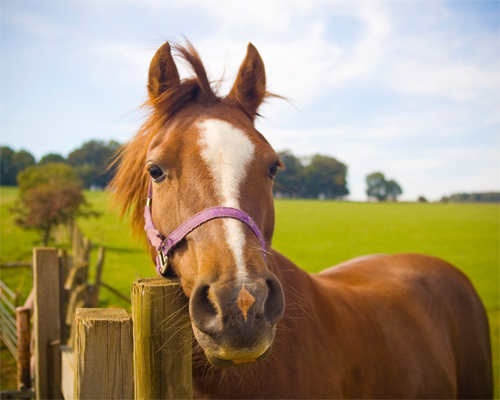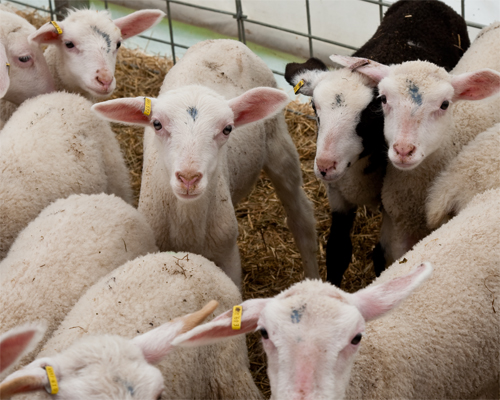
Fact Sheet FS1228
What Is Rabies?
Rabies is a deadly disease of animals and humans. It is endemic in New Jersey and there are over 300 cases in the state every year. Rabies is a virus that attacks the central nervous system in mammals (warm-blooded animals). The virus is present primarily in the saliva, brain tissue, and spinal fluid of a rabid animal and is transmitted by a bite, contamination of an open cut, or through contact with mucus membranes (nose, mouth, eyes). Rabies typically results in encephalitis (swelling of the brain), which can result in paralysis, blindness, aggression, mood changes, and other symptoms. Left untreated, rabies causes death. There is no treatment for rabies. Rabies is almost always fatal once the animal or human is infected (only two (2) humans have survived rabies in the United States in 16 years). The best way to deal with this disease is by vaccinating animals.
There are two forms of rabies: dumb and furious. Dumb rabies is observed as animals that are calmer than normal or expected. They are not affectionate, but they will not run from humans. Dumb rabies is more commonly seen in livestock. Wild animals normally avoid human contact, so if a wild animal does not seem cautious when you approach it, it may be rabid. The other form of rabies, furious rabies, is more commonly seen. This is the stereotypical rabid animal that is vicious and will attack without aggravation. If a mammal acts unusually aggressive, or displays any bizarre behavior, it may be rabid. Foaming at the mouth and excessive saliva are often not present!
How Is Rabies Transmitted?
Rabies is usually transmitted from the bite of an infected animal. However, because it is viral, it can enter through any open wound on the body. It can also enter through mucous membranes (nose, mouth, and eyes) and spread throughout the sensory neurons and salivary glands in the body. The virus is not hardy and cannot survive long outside of its host. Once dry, saliva containing the rabies virus is considered noninfectious.
What Animals Can Get Rabies?
Only mammals, including humans, can get rabies. In the United States, more than 7,000 animals per year, most of them wild, have been diagnosed as having the disease since 1995. In wild animals, rabies is most common in bats, raccoons, skunks, and foxes, but the disease has also been found in deer and in large rodents such as groundhogs and woodchucks. These animals represent 95% of the cases in the United States. (NOTE: It is illegal to keep these animals as pets in New Jersey.)
Cats, dogs, and livestock can get rabies, too, if they are not vaccinated. In New Jersey the vast majority of domestic animal rabies is found in cats. Small rodents (such as squirrels, rats, mice, hamsters, guinea pigs, gerbils, and chipmunks) and lagomorphs (such as rabbits and hares) are almost never found to be infected with rabies and have not been known to cause rabies among humans in the United States. Rabies has not been reported in birds, fish, insects, or reptiles.
What Are the Symptoms and Prevention of Rabies in an Animal?
Cats: Cats most consistently develop the furious form of rabies; however the dumb form does occur. The clinical signs include strange and abnormal behavior, abnormal meowing, eye discomfort in light (photophobia), restless aggression, muscle tremors and lack of coordination. Mandibular and laryngeal (relating to the larynx) paralysis is rare in cats.
- Prevention: There is an approved rabies vaccine for cats. Cat owners should routinely vaccinate for rabies. Vaccinations offer up to three (3) years of protection, depending on the vaccine used.
Cattle: Rabies is uncommon in cattle but there are often a few livestock cases when wildlife cases increase. An animal acting out of character is a clue - a normally gentle or tame animal may suddenly become skittish or aggressive or a typically wild animal may be unafraid. A big clue is an animal having trouble eating or drinking because it can’t swallow, a condition often mistaken for an obstruction in the mouth or throat. Signs include excessive salivation, behavior change, muzzle tremors, abnormal posture, bowel movement complications, yawning, abnormal reaction to light, abnormal appetite, sexual excitement, abnormal bellowing, aggression, decreased lactation, increased interest with sound or light, and pharyngeal (relating to the throat) paralysis. As a neurologic disease, many of these animals display a lack of voluntary coordination (ataxia), including instability in the hind end.
- Prevention: There is an approved rabies vaccine for cattle. It is effective for 1 year.
Dogs: Initial clinical signs in dogs are biting, aggression, hyperestesia (an abnormally acute sense of pain, heat, cold or touch), photophobic (being afraid of or sensitive to light), aggressive pica (appetite for non-nutritious foods), irritation, laryngeal (relating to the larynx) paralysis, muscle paralysis, roaming, abnormal barking, and excessive salivation. Usually infected dogs that are docile turn restless and infected dogs that are restless appear to be docile. Final clinical signs include coma, convulsions, and generalized paralysis.
- Prevention: There is an approved rabies vaccine for dogs and owners should routinely vaccinate for rabies. Vaccines are effective for up to three (3) years.
Ferrets: The ferret is a carnivore, but rabies is a rare disease in this species compared to dogs and especially cats. Ferrets have very thick, tough skin, and not all bites will penetrate, decreasing probability of the rabies virus to be transmitted from the rabid animal.
- Prevention: There is a killed virus vaccine labeled for ferrets that is given annually; recombinant vaccines have not yet been approved.
Goats: Reports of rabies in goats are rare, but the furious form of rabies appears to be more common. Symptoms in goats include aggressive behavior, excessive bleating, and salivation. Other signs could include drooling, inability to swallow food, depression, aggression, stupor, weakness, circling, excitation, blindness or any repetitive action.
- Prevention: Currently, there is no rabies vaccine labeled for goats, but off label vaccination with a sheep or cattle vaccine is considered effective and is often recommended by veterinarians for rabies prevention in goats living in endemic rabies areas such as New Jersey. The best prevention program is to prevent exposure. Goat owners are encouraged to provide adequate housing and fencing to prevent wild animals from approaching and attacking goats.
Horses: Early clinical signs of infection include muzzle tremors, pharyngeal (relating to the throat) paralysis, anorexia, depression, colic, and ataxia (lack of muscle control and often associated hind-end weekness). As the disease progresses clinical findings include abnormal posture, frequent whinnying, aggressiveness, kicking, biting, striking, head tossing, transient lameness, and apparent blindness. Over half of the clinical cases will be in the dumb form of rabies; however, the furious form will occur in 43% of infected horses. Horses in the finals stages of the disease lay down with head and neck still upright. This progresses to the horse lying flat out with paddling tremors, and eventually systemic paralysis and death. Signs and symptoms of rabies are very similar to other conditions such as Eastern Equine Encephalitis, West Nile, and Equine Herpesvirus (EHV-1). Any horse with neurological signs, especially if not currently vaccinated for rabies, should be considered a rabies suspect.
- Prevention: There is an approved equine rabies vaccine. Currently available vaccines should be administered annually.
Pigs: Pigs infected with rabies are rare. Early signs may include excitement, aggression, lack of coordination, excessive salivation, backwards walking, phantom chewing, and lethargy. Final stages of disease include depression, convulsions, and lying down. Onset is sudden with nervous twitching of the face muscles, fits and convulsions, rapid chewing, salivation, muscles spasms and posterior paralysis.
- Prevention: Currently, there is no approved rabies vaccine labeled for pigs. Owners are encouraged to provide adequate housing and fencing to prevent exposure to wild animals and potential attacks.
Rabbits: Although not common in domestic rabbits, they are highly susceptible to rabies virus infection. The symptoms of rabies vary depending on the species affected. The first sign of rabies is usually a change in the animal’s normal behavior. An animal need not be “foaming at the mouth” to have rabies. Some of the signs of rabies in an animal include: a general appearance of sickness, lethargy, fever, blindness, difficulty walking, abnormal salivating or slobbering, difficulty swallowing, loss of movement or partial paralysis of limbs, anxiety or irritability, aggression or other behavioral changes, dropping of the jaw or lack of mobility in the jaw (slack jaw).
- Prevention: Currently, there is no approved rabies vaccine for rabbits. The best prevention program is to prevent exposure. Rabbit owners are encouraged to provide adequate housing and fencing to prevent exposure to wild animals and potential attacks.
Sheep: Clinical signs of sheep are very similar to cattle infected with rabies. Typical symptoms include difficulty swallowing, excessive salivating, abnormal behavior, lethargy and lying down, tremors and other neurological symptoms, and paralysis. There may also be aggressive wool pulling and excessive bleating.
- Prevention: There are vaccines labeled for use in sheep. Vaccines are approved for 1–3 year duration in sheep depending on vaccine history and the product used.
Small Animals: Small pet mammals such as gerbils, hamsters and guinea pigs are born and raised in captivity and therefore are rarely exposed to the rabies virus.
- Prevention: Currently, there is no approved rabies vaccine for small animals. The best prevention program is to prevent exposure. Small animal owners are encouraged to provide adequate housing and fencing to prevent exposure to wild animals and potential attacks.
What Can You Do to Protect Your Animals From Rabies?
- Vaccinated pets serve as a buffer between rabid wildlife and humans. Consult with your veterinarian about vaccinations for your pets and livestock.
- Prevent contact with wild animals—provide adequate housing and fencing to prevent exposure to wild animals.
- Do not allow pets to roam free.
- Report all animal bites to the local animal control.
- If a wild animal comes on your property, contact your local animal control.
- Small animals should be kept indoors or kept in elevated hutches without exposed wire mesh floors.
- Small animals should be supervised at all times when in open areas outdoors.
- There is no antemortem (live animal) test for rabies. Animals must be euthanized before testing can be performed. Protect your animals for this deadly consequence by keeping them current on their vaccinations!
The State Department of Agriculture is recommending rabies vaccinations for all domestic livestock. Please talk with your veterinarian about this recommendation. There are liability implications for animal owners who choose not to follow these recommendations and expose their animals to the public. In New Jersey, rabies vaccination must be performed by a licensed veterinarian. Non-veterinarians cannot legally purchase and administer vaccine. If a vaccine is not administered by a licensed veterinarian, that animal is not legally considered to be vaccinated.
What if an Animal Is Bitten by a Suspected Rabid Animal?
If the animal has been in a fight with another animal call your veterinarian. A vaccinated pet may need a booster dose of rabies vaccine and informal observation for a period of time.
Euthanasia is typically recommended for an unvaccinated animal with a likely exposure to rabies. However, the animal can be quarantined for a period of up to six months at a secure facility with no direct contact with people or other animals. A quarantined animal cannot leave the quarantine area to go to shows, fairs, etc. If the animal exhibits any signs while quarantined, public health or animal control officials will order euthanasia and subsequent rabies testing. Under current New Jersey state regulations, vaccinated animals known to have been exposed to rabies with or without visible wounds are quarantined for 45 days.
For a detailed list of management procedures for vaccinated and unvaccinated animals exposed to rabies, visit tycoanimalcontrol.com/documents/Management_of_exposed_pets.pdf (PDF).
For regulatory procedures for domestic animal rabies exposures in New Jersey refer to tycoanimalcontrol.com/documents/Animal%20post%20expossure%20Confinement%20guidelines.pdf (PDF).
What Should a Person Do if an Animal Bite Occurs?
If you are bitten by an animal, wash the wound thoroughly with soap and water and seek medical attention immediately. The local health department or the county animal control office also should be notified immediately. The animal should be captured without damaging its head and only if direct contact with the animal can be avoided. If an apparently healthy domestic dog, cat or ferret bites a human, it must be captured, confined and professionally observed for 10 days following the bite. If the animal remains healthy during this period, it would not have transmitted rabies at the time of the bite. There is no reliable observation period established for non-domestic animals. If a person is bitten by a non-domestic animal and it is available for testing, testing should be done immediately. All animal bites should be reported to the local animal control office.
Summary
Rabies in small animals has been dramatically reduced in the United States since the introduction of rabies vaccination of domestic animals in the 1940s. As a consequence, the number of human deaths caused by rabies has declined to only a few cases per year. However, during the past several years, rabies in wildlife has skyrocketed. Each wildlife species carries its own rabies variant(s). These wildlife epizootics present a constant public health threat in addition to the danger of reintroducing rabies to domestic animals. Vaccination is the key to prevent rabies in animals and rabies transmission to human beings. Rabies is always fatal once the animal is infected.
References
Reviewed by:
- Dr. Manoel Tamassia, NJ State Veterinarian
- Dr. Matthew Edson, DVM, MICP
February 2014
Copyright © 2025 Rutgers, The State University of New Jersey. All rights reserved.
For more information: njaes.rutgers.edu.
Cooperating Agencies: Rutgers, The State University of New Jersey, U.S. Department of Agriculture, and Boards of County Commissioners. Rutgers Cooperative Extension, a unit of the Rutgers New Jersey Agricultural Experiment Station, is an equal opportunity program provider and employer.



